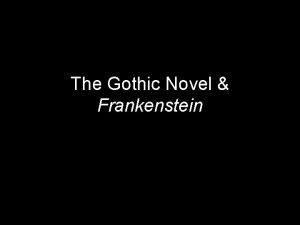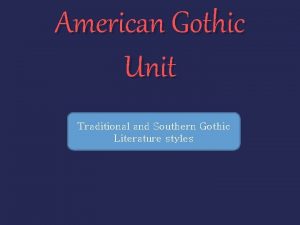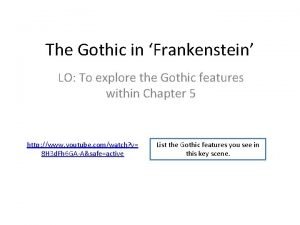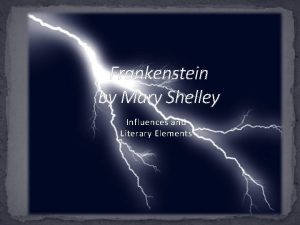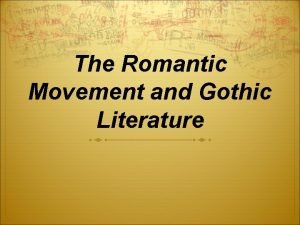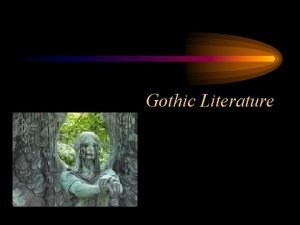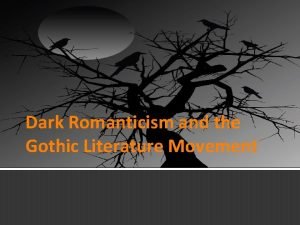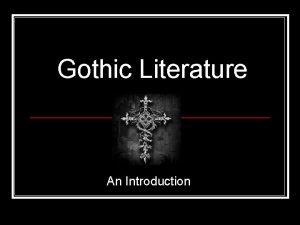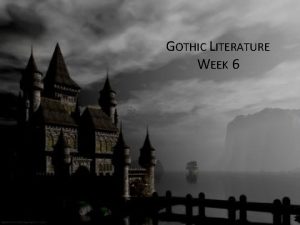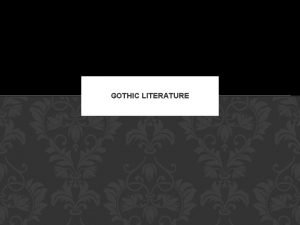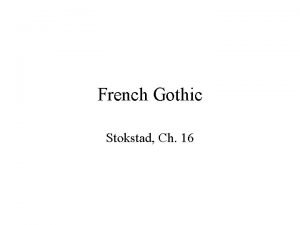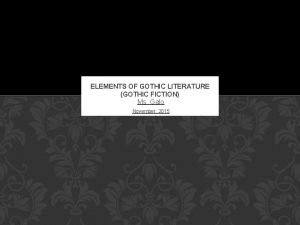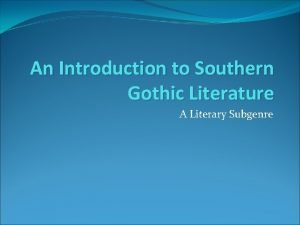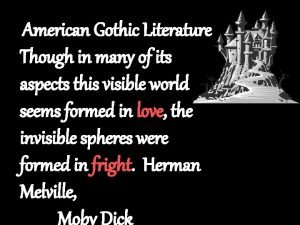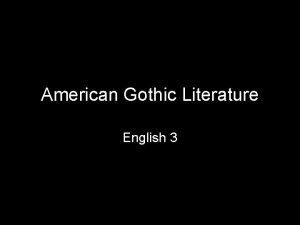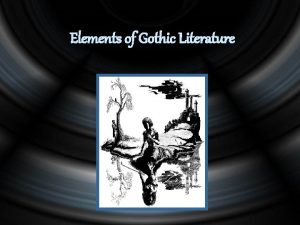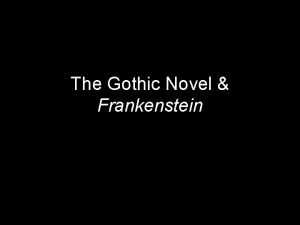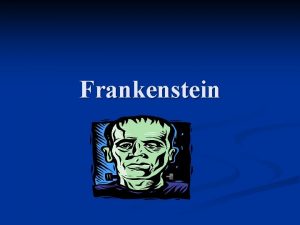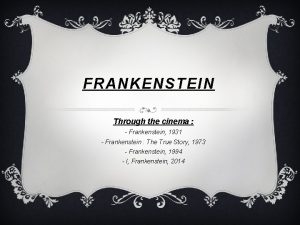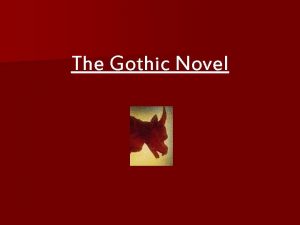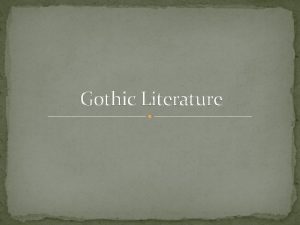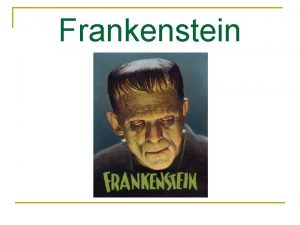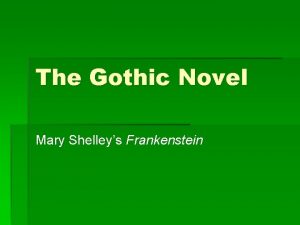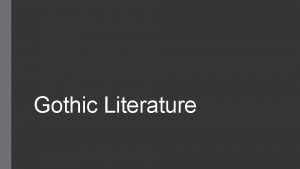Gothic Literature women and Frankenstein Gothic Literature A







![Mary Shelley, the non-feminist ► ► ► Women are “quite different creatures [from men]—better Mary Shelley, the non-feminist ► ► ► Women are “quite different creatures [from men]—better](https://slidetodoc.com/presentation_image_h2/e2e7bcb5cb4493ceaa2a7e1eecd48cf7/image-8.jpg)







- Slides: 15

Gothic Literature, women, and Frankenstein

Gothic Literature ►A novel in which magic, mystery, and chivalry are chief characteristics. ► Horrors abound: one may expect an inanimate object to come to life, ghosts, clanking chains, and charnel houses. § *charnel house—vault or building where human skeletal remains are stored.

Elements of the Genre ► Claustrophobic confinement and threatening architecture. ► Underground pursuit and subterranean peril. ► Supernatural encounters. ► Sentience (awareness) of architecture ► Extraordinary positions and lethal predicaments

Elements cont’d ► Suspension of rationality and morality ► Spectral and demonic machinery ► Atmospheric superiority of evil ► Psychopathic and destructive emotions ► Genealogical complications, jeopardy, mysteries.

Gothic Literature and Women ► Despite a number of male achievements in Gothic literature (Horace Warpole writes the first), the genre has held a special attraction for women. ► In the early days of the genre, reading Gothic fiction became a favorite pastime of the middleclass female ► Women, oppressed by needlepoint, whalebone stays, psychological frustrations, shame, and babies, found reading/writing these stories as a way to outline their pain. ► Gothic feminism seeks to escape the female body though a dream of turning weakness into strength

Shelley as a Gothic novelist pain abounds in Frankenstein ► While writing the novel, Shelley was dealing with a number of biological matters ► Ellen Moers claims that the novel deals with “the motif of revulsion against newborn life, and the drama of guilt, dread, and flight surrounding birth and its consequences. . . Frankenstein seems to be distinctly a woman’s mythmaking on the subject of birth. ” ► Female

According to Leonard Wolf. . . The novel is a living artifact of the age-old risk of love. Mary Shelley, eighteen years old and scared, gave expression to an insight that is as simple as it is heartbreakingly true: women have literally everything to fear from men. ► The flattery of women as primordial life-givers, as instinctive nurturers is overshadowed by the fact that death sits on her side of the bed. This is not rhetoric. One is talking about real death. . It is a commonplace, an age-old fact that men and women both know, but which only women have to confront; and it is this fact, deeply experienced by Shelley, that gives Frankenstein a special eeriness. ► ►
![Mary Shelley the nonfeminist Women are quite different creatures from menbetter Mary Shelley, the non-feminist ► ► ► Women are “quite different creatures [from men]—better](https://slidetodoc.com/presentation_image_h2/e2e7bcb5cb4493ceaa2a7e1eecd48cf7/image-8.jpg)
Mary Shelley, the non-feminist ► ► ► Women are “quite different creatures [from men]—better though weaker. ” Influenced by guilt of her mother’s untimely death Death of 3 of her 4 children She suffered quite severely in pregnancy; her husband was rarely supportive and often involved in other affairs during her pregnancies women are completely excluded from the creation process in Frankenstein; men sure do make a mess of things!

Female heroines in the Gothic tradition Typical Gothic female is blameless, virginal, innocent, good (absolute) ► Triumphs over various passive-aggressive strategies (Gothic villain, typically male) ► Depicts woman as innocent victims of a corrupt and evil patriarchy ► Argues that demure, docile behavior is hardly a protection (or virtue) ►

From the critics. . . ► Diane Long Hoeveler: Gothic feminism was born when women realized that they had a formidable external enemy—the lusty, evil patriarch, in addition to their own worst internal enemy—their consciousness of their own sexual difference, perceived as weakness. § From “Mary Shelley and Gothic Feminism: The Case of ‘The Mortal Immortal’

Mary Shelley as the Gothic hero ► Carries a heavy intellectual burden as the result of her parentage, and even her marriage ► Her real (and imagined) victimization, first as a result of being Percy’s wife, then later his widow ► Some critics suggest that while Percy haunts her works, the true hero-villains of her stories were her parents ► Mary Shelley felt destined to fulfill her mother’s aborted philosophical and literary visions

As such. . . ► Frankenstein stands paradoxically as the Gothic embodiment of the critique of Gothic feminism ► Shelley puts her fictional women into that world and reveals that the sensitive male hero is a mad egotist intent on usurping feminine values and destroying all forms of life in his despotic quest for phallic mystery ►Taken from Hoeveler

Hoeveler: Frankenstein punishes every female body in that text. . ► It replaces the maternal womb with chemical artifice, only to blast masculine attempts at procreation as futile and destructive.

Gothic feminism and Mary Shelley ► Realization that women would always be life’s victims, not simply because of external forces, but because their own bodies cursed them to forever serve the wheel of corruption. ► Bringing to life a child who would die, or perhaps soon die, condemned women to serve a merciless god—the cycle of generation, birth, and death– in a way that men did not. ► Could Victor be her own person striving to overcome his/her own weaknesses? ► Hoeveler: “railing against the female body. . is the only [gender] position Mary Shelley can take”

Consider. . . ► Wolf contends that Shelley’s novel is a not a “properly Gothic novel, ” though it does inspire fear. ► Primarily because a young woman of genteel breeding is usually at the center of the work ► What about Shelley’s work does fit the “bill” of Gothic fiction? ► Where does this novel address the condition of women? Would you classify Shelley as a feminist? ► Where does it call for social change (in any arena)?
 Gothic writing meaning
Gothic writing meaning American gothic writers
American gothic writers Gothic elements in frankenstein
Gothic elements in frankenstein Frankenstein gothic novel
Frankenstein gothic novel Gothic literature englightenment
Gothic literature englightenment Romantic vs gothic architecture
Romantic vs gothic architecture Dark romantic literature
Dark romantic literature Gothic novels definition
Gothic novels definition Gothic fiction meaning
Gothic fiction meaning Gothic literature quiz
Gothic literature quiz Gothic sentences
Gothic sentences French gothic sculpture
French gothic sculpture Elements of gothic literature
Elements of gothic literature Southern gothic painting
Southern gothic painting Gothic literature elements
Gothic literature elements Gothic elements
Gothic elements
